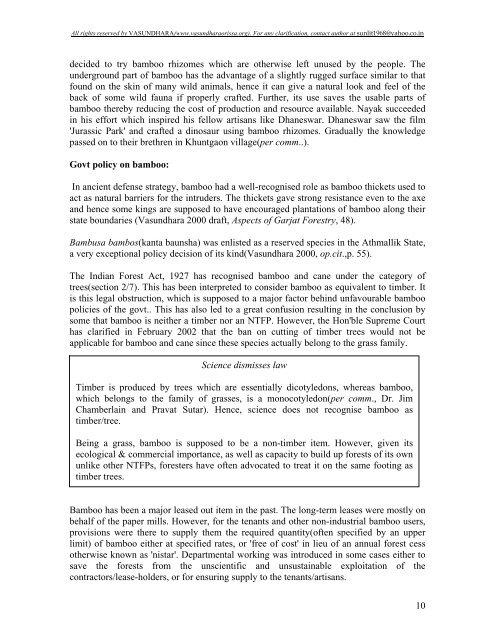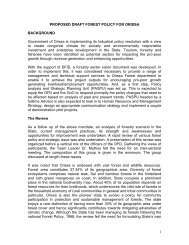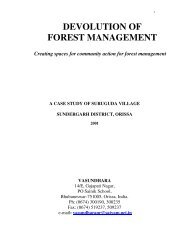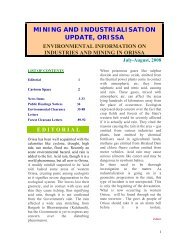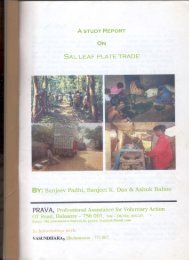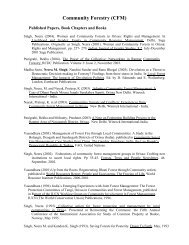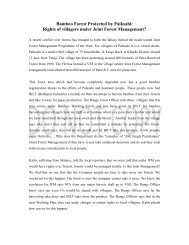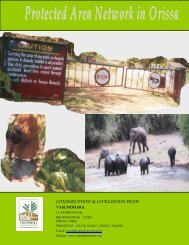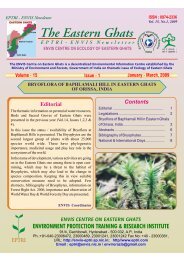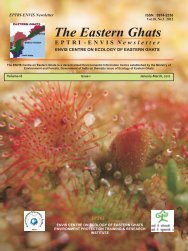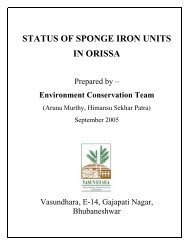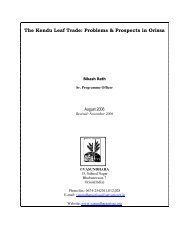Bamboo in Orissa: Trade and Livelihood Perspective - Vasundhara
Bamboo in Orissa: Trade and Livelihood Perspective - Vasundhara
Bamboo in Orissa: Trade and Livelihood Perspective - Vasundhara
You also want an ePaper? Increase the reach of your titles
YUMPU automatically turns print PDFs into web optimized ePapers that Google loves.
All rights reserved by VASUNDHARA(www.vasundharaorissa.org). For any clarification, contact author at sunlit1968@yahoo.co.<strong>in</strong><br />
decided to try bamboo rhizomes which are otherwise left unused by the people. The<br />
underground part of bamboo has the advantage of a slightly rugged surface similar to that<br />
found on the sk<strong>in</strong> of many wild animals, hence it can give a natural look <strong>and</strong> feel of the<br />
back of some wild fauna if properly crafted. Further, its use saves the usable parts of<br />
bamboo thereby reduc<strong>in</strong>g the cost of production <strong>and</strong> resource available. Nayak succeeded<br />
<strong>in</strong> his effort which <strong>in</strong>spired his fellow artisans like Dhaneswar. Dhaneswar saw the film<br />
'Jurassic Park' <strong>and</strong> crafted a d<strong>in</strong>osaur us<strong>in</strong>g bamboo rhizomes. Gradually the knowledge<br />
passed on to their brethren <strong>in</strong> Khuntgaon village(per comm..).<br />
Govt policy on bamboo:<br />
In ancient defense strategy, bamboo had a well-recognised role as bamboo thickets used to<br />
act as natural barriers for the <strong>in</strong>truders. The thickets gave strong resistance even to the axe<br />
<strong>and</strong> hence some k<strong>in</strong>gs are supposed to have encouraged plantations of bamboo along their<br />
state boundaries (<strong>Vasundhara</strong> 2000 draft, Aspects of Garjat Forestry, 48).<br />
Bambusa bambos(kanta baunsha) was enlisted as a reserved species <strong>in</strong> the Athmallik State,<br />
a very exceptional policy decision of its k<strong>in</strong>d(<strong>Vasundhara</strong> 2000, op.cit.,p. 55).<br />
The Indian Forest Act, 1927 has recognised bamboo <strong>and</strong> cane under the category of<br />
trees(section 2/7). This has been <strong>in</strong>terpreted to consider bamboo as equivalent to timber. It<br />
is this legal obstruction, which is supposed to a major factor beh<strong>in</strong>d unfavourable bamboo<br />
policies of the govt.. This has also led to a great confusion result<strong>in</strong>g <strong>in</strong> the conclusion by<br />
some that bamboo is neither a timber nor an NTFP. However, the Hon'ble Supreme Court<br />
has clarified <strong>in</strong> February 2002 that the ban on cutt<strong>in</strong>g of timber trees would not be<br />
applicable for bamboo <strong>and</strong> cane s<strong>in</strong>ce these species actually belong to the grass family.<br />
Science dismisses law<br />
Timber is produced by trees which are essentially dicotyledons, whereas bamboo,<br />
which belongs to the family of grasses, is a monocotyledon(per comm., Dr. Jim<br />
Chamberla<strong>in</strong> <strong>and</strong> Pravat Sutar). Hence, science does not recognise bamboo as<br />
timber/tree.<br />
Be<strong>in</strong>g a grass, bamboo is supposed to be a non-timber item. However, given its<br />
ecological & commercial importance, as well as capacity to build up forests of its own<br />
unlike other NTFPs, foresters have often advocated to treat it on the same foot<strong>in</strong>g as<br />
timber trees.<br />
<strong>Bamboo</strong> has been a major leased out item <strong>in</strong> the past. The long-term leases were mostly on<br />
behalf of the paper mills. However, for the tenants <strong>and</strong> other non-<strong>in</strong>dustrial bamboo users,<br />
provisions were there to supply them the required quantity(often specified by an upper<br />
limit) of bamboo either at specified rates, or 'free of cost' <strong>in</strong> lieu of an annual forest cess<br />
otherwise known as 'nistar'. Departmental work<strong>in</strong>g was <strong>in</strong>troduced <strong>in</strong> some cases either to<br />
save the forests from the unscientific <strong>and</strong> unsusta<strong>in</strong>able exploitation of the<br />
contractors/lease-holders, or for ensur<strong>in</strong>g supply to the tenants/artisans.<br />
10


